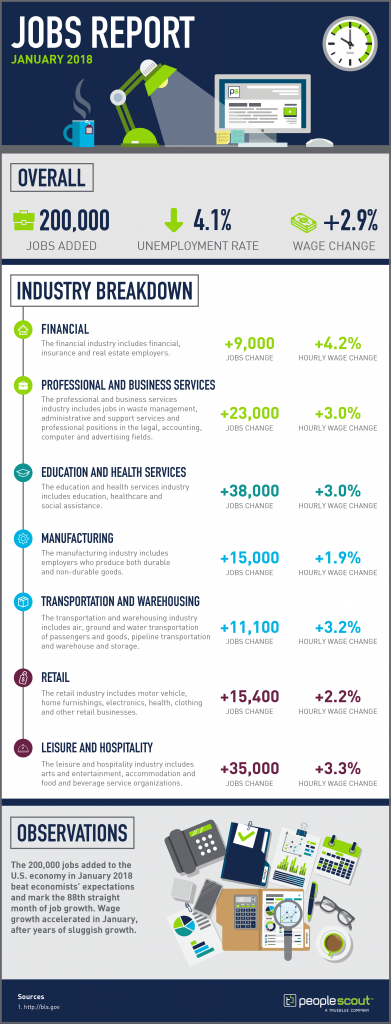The Labor Department released the January jobs report with higher than expected job gains and accelerating wage gains.

The Numbers
200,000: The U.S. added 200,000 jobs in January
4.1%: The unemployment remained at 4.1 percent
2.9%: Wages increased 2.9 percent over the past year
The Good
The 200,000 jobs added to the economy beat economists’ expectations for the first month of 2018. January marks the 88th consecutive month of growth for the economy. The unemployment rate has remained at the low of 4.1 percent since October 2017.
The biggest highlight in this report is the wage growth. Throughout 2017 many economists questioned what held back wages as the unemployment rate fell. Toward the end of the year, we noted that there were signals that wage growth could accelerate in 2018. January’s jobs report shows hourly wage growth of 2.9 percent, which is the highest since 2009, according to CNN. However, the New York Times warns not too read too strongly into January’s numbers because there have been short spikes at other points in the recovery from the Great Recession.
The Bad
The bad news in this jobs report isn’t immediately obvious, however the markets did fall Friday morning. The New York Times reports that this may be because January’s jobs report gives signs that future U.S. growth could be slower than expected.
The Unknown
Heading into 2018, there are still questions about how the tax cut will impact the U.S. economy. Some employers have offered one-time bonuses to employees, citing the tax cut. Those bonuses are not counted in the hourly wage numbers in this report. According to the Wall Street Journal, that means that consumers have more purchasing power than the wage gain number reflects. Additionally, the increased tax savings could lead some employers to increase wages.
The Global Unemployment Report – Q3 2017
PeopleScout partnered with HRO Today to produce a quarterly summary of international unemployment metrics for key countries in North America, Latin America, EMEA and APAC, including highlighting the countries with the most highly skilled workers. This issue of the report focuses on Q3 2017.
Click below to access the eBook.
DOWNLOAD WHITE PAPER


